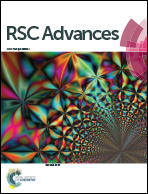A novel fluorescein-based colorimetric probe for Cu2+ detection†
Abstract
A new colorimetric probe, 5-chlorosalicylaldehyde fluorescein hydrazone (CSFH), has been synthesized and characterized by infrared spectroscopy, nuclear magnetic resonance spectroscopy, mass spectrometry, elemental analysis and X-ray single crystal diffraction. CSFH had nearly no absorption in visible region. In the presence of copper(II) ion a rapid color changes from colorless to yellow along with an obvious new absorption band appeared at 495 nm. CSFH was highly selective to Cu2+ only in the aqueous solution, instead of common metal ions. The absorbance intensity and the color of CSFH solution increased gradually with the increase of Cu2+ concentration. Common metal ions did not show any interference on the determination of Cu2+. The chemical stoichiometric ratio between the CSFH and Cu2+ was 1 : 1 and corresponding association constant was 6.85 × 105 L mol−1, and the linear range for Cu2+ detection was 0.25–14 μmol L−1. The detection limits were 0.25 μmol L−1 and 1.0 μmol L−1 of Cu2+ using the UV-Vis changes and the visual color changes by the naked eye respectively. The proposed method was applied to the determination of Cu2+ in drinking water samples and the recoveries were 96–106%. The preparation of CSFH exhibited the quick, simple and facile advantages. The results showed that CSFH can be a good candidate for simple, rapid and sensitive colorimetric detection of Cu2+ in aqueous solution.


 Please wait while we load your content...
Please wait while we load your content...